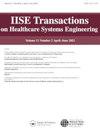Simulation-optimization of automated material handling systems in a healthcare facility
IF 1.5
Q3 HEALTH CARE SCIENCES & SERVICES
IISE Transactions on Healthcare Systems Engineering
Pub Date : 2020-06-17
DOI:10.1080/24725579.2021.1882622
引用次数: 5
Abstract
Abstract Automated material handling systems are used in healthcare facilities to optimize material flow, minimize workforce requirements, reduce risk of contamination, and reduce work injuries. This paper develops a case study using data from Greenville Memorial Hospital (GMH) in South Carolina, USA. The case study is focused on the delivery of surgical case carts to operating rooms at GMH via Automated Guided Vehicles (AGVs). This study proposes a framework that integrates data analysis with system simulation and optimization. The study addresses the following research questions: (1) Redesign of the pathways: Do performance measures, such as travel time and task completion time, improve after a redesign of AGV pathways? (2) Operational fleet sizing: Do performance measures, such as travel time and task completion time, improve when the number of AGVs used daily is controlled by the volume of surgical cases? If this is true, then how many AGVs should be used daily? To address research question (1), we compare two AGV pathway designs via an extensive sensitivity analysis. To address research question (2), we use a simulation-optimization model to evaluate the performance of the system for different fleet sizes. Finally, we conduct a pilot study at GMH to validate the results of our analysis. This study indicates that the proposed solution, which uses a smaller fleet of AGVs than currently used at GMH, leads to significant reductions in congestion and travel times, and increased utilization of AGVs.医疗机构中自动化物料处理系统的仿真优化
自动化物料处理系统用于医疗保健设施,以优化物料流,最大限度地减少劳动力需求,降低污染风险,并减少工伤。本文利用美国南卡罗来纳州格林维尔纪念医院(GMH)的数据进行案例研究。该案例研究的重点是通过自动导向车辆(agv)将手术病例车运送到GMH的手术室。本研究提出一个整合数据分析与系统模拟与优化的架构。该研究解决了以下研究问题:(1)路径的重新设计:重新设计AGV路径后,绩效指标(如旅行时间和任务完成时间)是否有所改善?(2)运营车队规模:当每天使用的agv数量由手术病例量控制时,绩效指标(如行程时间和任务完成时间)是否有所改善?如果这是真的,那么每天应该使用多少agv ?为了解决研究问题(1),我们通过广泛的敏感性分析比较了两种AGV路径设计。为了解决研究问题(2),我们使用仿真优化模型来评估不同车队规模下系统的性能。最后,我们在GMH进行了一项试点研究,以验证我们的分析结果。这项研究表明,拟议的解决方案使用比GMH目前使用的agv更小的车队,可以显著减少拥堵和旅行时间,并提高agv的利用率。
本文章由计算机程序翻译,如有差异,请以英文原文为准。
求助全文
约1分钟内获得全文
求助全文
来源期刊

IISE Transactions on Healthcare Systems Engineering
Social Sciences-Safety Research
CiteScore
3.10
自引率
0.00%
发文量
19
期刊介绍:
IISE Transactions on Healthcare Systems Engineering aims to foster the healthcare systems community by publishing high quality papers that have a strong methodological focus and direct applicability to healthcare systems. Published quarterly, the journal supports research that explores: · Healthcare Operations Management · Medical Decision Making · Socio-Technical Systems Analysis related to healthcare · Quality Engineering · Healthcare Informatics · Healthcare Policy We are looking forward to accepting submissions that document the development and use of industrial and systems engineering tools and techniques including: · Healthcare operations research · Healthcare statistics · Healthcare information systems · Healthcare work measurement · Human factors/ergonomics applied to healthcare systems Research that explores the integration of these tools and techniques with those from other engineering and medical disciplines are also featured. We encourage the submission of clinical notes, or practice notes, to show the impact of contributions that will be published. We also encourage authors to collect an impact statement from their clinical partners to show the impact of research in the clinical practices.
 求助内容:
求助内容: 应助结果提醒方式:
应助结果提醒方式:


